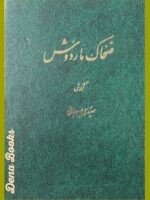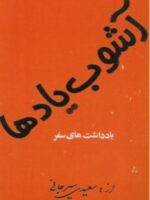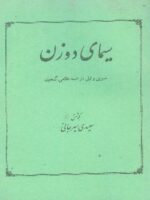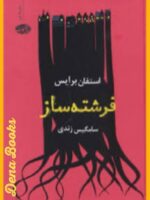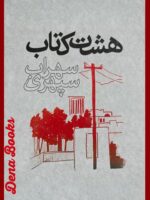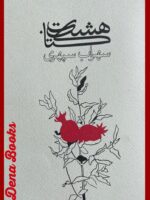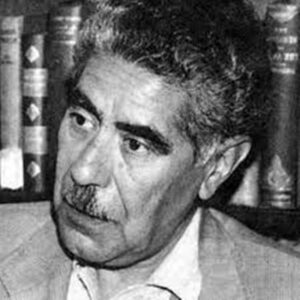
Ali Akbar Sa’idi Sirjani, a famous poet, literary figure, author, and researcher, was one of the victims of a series of political murders that have come to be known as “Chain Murders.” Information regarding his life, activities, and the manner in which he was killed, was obtained from numerous sources including a website dedicated to him, in which are posted letters from Mr. Sa’idi Sirjani to the Leader of the Islamic Republic, Aytallah Khamenei (not dated), the then President Hashemi Rafsanjani (19 October 1992), and to the judiciary (24 February 1994); his daughter, Sayeh Sa’idi Sirjani’s interview with Voice of America. Other sources include: The Tragedy of Democracy in Iran, From Sheik of San’an to Death in Prison, and Yas-o-Das (“Jasmine and Sickle”); Jomhuri Eslami, Kayhan, and Ettela’at newspapers. For detailed bibliography see footnotes*.
Mr. Sa’idi was married in 1960-61 and had three daughters. According to one of his friends, he was a freedom-loving and broad-minded who was free from ideological attachments and at the service of the Iranian culture.
His extensive and profound knowledge of Persian literature and Iranian history, his insight and wit, his simple writing style accompanied by humor and amphibology, his warm and friendly speaking manner and his innate talent in story-telling, made Mr. Sa’idi Sirjani a unique writer with his own style.[1] His choice of the use of metaphors and allegories in critiquing authoritarian relations, in addition to his character traits such as frankness, courage, broad-mindedness, and independent thinking and doing, led to a great many professional and social deprivations.
Professional Life
Mr. Sa’idi Sirjani completed his elementary school studies in [the town of] Sirjan (Kerman) and then entered Daneshsaraye Moqadamatie Kerman (“Kerman Preparatory School”). He then studied philosophy at Tehran University and, upon obtaining his Bachelor’s Degree, returned to Kerman to become a teacher in Sirjan and [the city of] Bam. Five years later, he returned to Tehran and began working at “Iran Cultural Foundation,” founded By Dr. Parviz Khanlari, first as the person in charge of book publishing, then as Scientific and Technical Deputy. He asked to be retired from Iran Cultural Foundation in 1978, prior to the Revolution.
In addition to working at the “Iran Cultural Foundation,” he taught at [Tehran University] Faculty of Literature and at the Foundation’s Research Department, while publishing his own works. After the Revolution, he continued to write, conduct research, and work with a number of literary publications. In 1988, he went to the United States at the invitation of Columbia University where he taught Persian Language and Literature for a year. In subsequent years, he worked with Encyclopedia Iranica[2].
Published and Unpublished Work
Mr. Sa’idi Sirjani published his first works entitled Majmu’eh Shirin Sokhanane Gomnam and Suz-o-Saz, a book of poetry, while he was still a student at Tehran University. He gradually became one of the most famous figures in Iranian literature with his own unique writing style. In 1961, he began his collaboration with Dehkhoda Dictionary at the invitation of Dr. Mo’in. With the establishment of the Iran Cultural Foundation, he concentrated his research work there.
Mr. Sa’idi Sirjani authored seventeen books, collected and made corrections to at least six well-known Persian literary works, and worked with literary publications and magazines. Among his most important books are Afsaneh ha (Tales), Simaye Do Zan (Faces of Two Women), Zahhake Mardush, Bichareh Esfandiar (Poor Esfandiar). His most important research work is Tarikhe Bidarie Iranian (History of Iranian Awakening). He also made valuable contribution to research with the correction and editing of Zakhireh Kharazmshahi, Vaqaye Ettefaqieh, Surabadi Interpretation (a six volume interpretation of a Koran from the 5th Century A.H.). In the late 1980’s, he also published a number of articles in Ettela’at newspaper.
Before and after the 1979 Revolution, Mr. Sa’idiSa’idi Sirjani’s books and articles were subjected to governmental censorship. Tales was banned before the Revolution. After the Revolution, the publication of the story of “Sheik of San’an” in Negin Magazine, in 1979, led to the latter’s closure. In subsequent years, most of his books were banned. Starting in 1988, even his already published works were not permitted distribution.
Sa’idi Sijani Protests Publication Ban
Following the ban, Mr. Sa’idi Sirjani wrote a series of open letters to the authorities including the Minister of Culture and Guidance, the Head of the Judiciary, the Leader of the Revolution, Majless (Iranian Parliament) representatives, and his compatriots, asking for the ban to be lifted. He criticized religious authoritarianism in a language riddled with humor, metaphors, allegories, and double-entendres. In 1992, in a letter to the then-President, he talked about the ban on thousands of his books lingering in printing houses:
“Seventeen of my works are rotting in Bahman, Katibeh, and Khajeh printing houses since 1988, as follows: six volumes of ‘Surabadi Interpretation’ (which has cost 2 million Tumans just to typeset), two volumes of ‘History of Iranian Awakening’ (fifth printing), ‘Faces of Two Women’ (fourth printing), ‘Ashube Yadha’ (third printing), ‘Ey Kutah Astinan’, ‘Tahe Bassat’, ‘Poor Esfandiar’ (first printings), which have been printed and bound and are awaiting permission to distribute. Also, there is [the issue of] the second printing of ‘Dar Astine Moraqa’ which has been destroyed.” (Letter to Heshemi Rafsanjani, Sa’idi Sirjani Website).”
Mr. Sa’idi Sirjani expressly declared that he did not belong to any political parties or groups (third letter to Ayatollah Khamenei). [Also, prior to the Revolution], at the bottom of a document issued by the School of Literature professors declaring their adhesion to the Rastakhiz Party, he wrote: “I hereby declare my hatred of the [fake] Rastakhiz Party [ordered by the Shah].” (letter to compatriots, [his] will).
In 1992 and 1993, Mr. Sa’idi Sirjani wrote three open letters to the Leader of the Islamic Republic, Ayatollah Khamanei, criticizing the suffocating police-state atmosphere prevailing over cultural and media matters, and protested the reigning political and religious authoritarianism. Ayatollah Khamenei provided a very harsh response to one of these letters through Kiumars Saberi Fumani.[3] The tone of the response was so hostile that according to Mr. Sa’idi Sirjani “even the messenger felt ashamed to relate it, and it was not something any devout Moslem would do.” Sa’idi wrote his last letter to the Leader as an answer to the latter’s response, and, as he himself would admit, [thereby] ordered [the firing squad to] fire:
“I am a human being, [freedom-loving, liberal, and broadminded], as attested to by this letter, which [in itself] constitutes the order to fire and the drinking from the cup of hemlock (reference to the death of Socrates). Let future generations know that in the calamitous land that is Iran, there did exist those who courageously gave up their lives and faced death like men.” (Sa’idi Sirjani Website).
The arrest of Mr. Sa’idi Sirjani’s and the vilification hurled at him by the official media stirred more than sixty of his fellow authors to send a letter of protest to the head of the judiciary. The letter’s initiators were summoned to the Information Ministry and advised to retract it. The pressure and the intimidation to which the writers had been subjected prompted them to officially reconstitute the Iranian Writers’ Association. To explain their actions, they wrote a manifesto that has become famous in Iran as the “Declaration of 134” (for the number of its signatories). The writers claimed it as their “natural, social and civil right” to “reach the public in a free and unhampered manner,” and embraced as their “principal goal” the “removal of all obstacles on the road to freedom of thought, freedom of expression and freedom of publication. Amnesty International (April 28, 1994 and November 28, 1994), Human Rights Watch (February 29, 1996), United Nations Human Rights Commission (March 11, 1996), and the United Nations’ Special Rapporteur on the Situation of Human Rights (October 14, 1994 and January 16, 1995) issued statements condemning the arrest and murder of Mr. Sa’idi Sirjani and requiring proper investigation of his death and the
Short background on the “Chain Murders”
“Chain Murders” refers to a set of disappearances and extra-judicial killings of writers and political dissidents which occurred mainly in the 1990’s. In January 1999, the Ministry of Intelligence published an announcement in which it squarely put the blame for four such killings (those of Dariush and Parvaneh Foruhar, Mohammad Mokhtari, and Mohammad Ja’far Puyandeh) on rogue elements within the Ministry, without providing any explanation as to the causes and manner of killing of tens of [other] dissidents and writers.
A number of the Ministry of Intelligence agents were arrested and charged with the above-mentioned four persons’ murders. On June 20, 1999, it was announced that the primary suspect, Sa’id Emami, had committed suicide in prison. According to the victims’ lawyers, numerous pages of Emami’s confession had been deleted from the Chain Murders’ file. Based on independent research and the confessions of [a number of] the accused, however, the elimination of dissidents – the magnitude of which is still not clear- was the official policy of the Islamic Republic of Iran’s Ministry of Information for over a decade.
Mr. Sa’idi Sirjani’s name has repeatedly been mentioned as a victim of “Chain Murders” in the print media, by human rights organizations, and by writers. Amnesty International’s November 1994 report and Human Rights watch’s 1994 report make mention of his death under suspicious circumstances. In his report of January 16, 1995, the United Nations Special Rapporteur, Reynaldo Galindo Pohl, also makes reference to Mr. Sa’idi Sirjani’s suspicious murder, quoting from an interview with [author] Hushang Golshiri.
Newspapers such as Asr-e Azadegan (December 16, 1999), Sobhe Emrooz (August 15 and September 19, 1999), and Arzesh (December 4, 1999), considered Mr. Sai’di Sirjani as one of the tens of victims of Chain Murders. Also, in January 2000, the United Nations Special Rapporteur called on the Islamic Republic authorities to investigate the murders of more than fifty political dissidents: The authorities were asked to consider “a much wider scenario … one that involved 50 or more unexplained deaths in recent years. Included were the 1994 deaths of three Christian ministers which had been officially attributed to the Mujahedin, the deaths of Sunni community leaders, and the deaths of dissidents in bombings in Europe.” (UN Special Representative Report, January 18, 2000)
Arrest and Detention
Mr. Sa’idi Sirjani was arrested by security forces on March 15, 1994, upon leaving his home. On March 16, Jomhuri Eslami newpaper published the news of Mr. Sa’idi’s arrest as well as that of Niaz Kermani.[4] According to Mr. Sa’idi Sirjani’s daughter, security forces then searched his home, confiscated all his hand-written material as well as books ready to be published, unpublished articles and research work, and sealed off his personal library. (Sa’idi Sirjani Website; Interview with Voice of America).
Mr. Sirjani spent his time in detention in solitary confinement at a Ministry of Information safe house. For close to nine months, he had no phone contacts or visitations with members of his family. He was deprived of his right to access and retain an attorney. His family had no knowledge of his condition or whereabouts, other than the letters and news ascribed to him, occasionally published in government-run press and media.
According to claims made by the Ministry of Information officials, Mr. Sa’idi Sirjani visited, during his detention Ayatollah Khomeini’s shrine several times, as well as war-torn regions in southern Iran. (Deputy Minister of Information Sa’id Emami’s speech at Hamedan University in the fall of 1996, article by Mr. Sirjani’s interrogator in International Ettela’at, No. 143).
Trial
No trial was ever conducted following Mr. Sa’idi Sirjani’s arrest. After human rights groups advocated on his behalf, the head of Majless’ human rights committee declared in writing that Mr. Sa’idi Sirjani would be tried in public, but such a trial never materialized. (From Sheik of San’an to Death in Prison, page 8).
Charges
The day following his arrest, the semi-official Jomhuri Eslami newspaper, quoting “reliable sources,” announced the charges against Mr. Sa’idi Sirjani as being “distribution of illicit drugs and alcoholic beverages.” (March 16, 1994). A few weeks later, the Ministry of Information’s Director of Internal security declared the charges against Mr. Sa’idi Sirjani as being “transportation, distribution, and use of illicit drugs,” “production, maintenance, and distribution of alcoholic beverages,” “obscenely immoral activities and homosexuality,” “contact with a network of SAVAK officers connected to the Nojeh coup d’état and bombing activities,” “contact with foreign intelligence services,” and “receiving considerable amounts of foreign currency from anti-revolutionary networks in the United States and Britain.” (Jomhuri Eslami, April 25, 1994).
In an oral message transmitted through Kiumars Saberi Fumani to Mr. Sa’idi Sirjani prior to his arrest, the Leader of the Islamic Republic had declared him an “apostate” and “non-believer in Islam”, considering his writings and criticisms “an attack on Islam or the foundations of Islamic rule.” (Third letter to Ayatollah Khamenei). Additionally, Kayhan, Kayhan Havai, and Jomhuri Eslami newspapers intermittently leveled numerous charges against Mr. Sa’idi Sirjani, both before and after his arrest, including “member of the Tudeh Party, at the service of the Shah, SAVAK agent, atheist, infidel, traitor, spy, singer of praises of the [Shah’s] court, agent of [world] arrogance (mostly referring to the U.S.). (Sa’idi Sirjani Website). According to Mr. Sirjani himself, a gathering of “Hezbollah” individuals around his home had called him “the second Salman Rushdie” [against whom Ayatollah Khomeini, the founder of the Islamic Republic had issued a death fatwa] and had asked that he be dealt with. (TV Interview in Los Angeles).
Evidence
There is no precise information on the evidence presented against Mr. Sa’idiSa’idi Sirjani. However, according to security authorities, “Sa’idi’s confessions made during detention”, as well as his background and the records existing at the Ministry of Information, constitute the basis for the charges against him. (Jomhuri Eslami, April 25, 1994).
According to then-Deputy Minister of Information Sa’id Emami, dozens of hours of TV confessions and more than 1700 pages of articles were obtained from Mr. Sa’idi Sirjani, some of which were broadcast on “Hoviat,”[5] a program on state-run TV. (Deputy Minister of Information Sa’id Emami’s speech at Hamedan University in the fall of 1996, Tragedy of Democracy in Iran). Mr. Sa’idi made confessions on “Hoviat” in which he accepted such charges as moral corruption, espionage, and use of opium.
During Mr. Sa’idi Sirjani’s detention, numerous pieces ascribed to him were published in state-run press, including Ettela’at and Jomhuri Eslami newspapers. In these publications, which were in the form of notes, interviews (Jomhuri Eslami), letter to the interrogator (International Ettela’at) letter to “Dear Kayhanis” (July, 1994), and a report of a visit to war-torn regions, Mr. Sa’idi Sirjani is reported to have made statements, which were contrary to his beliefs, his books, and his articles.
In the course of one of the interviews, Mr. Sa’idi Sirjani implied being under duress: “… a hard knock to my spirit is the issue of my writings and books after the Revolution…” (Jomhuri Eslami, October 26, 1994).
Furthermore, in the last years of his life, Kayhan and Kayhan Havai newspapers published numerous articles whereby they leveled various charges against Mr. Sa’idi Sirjani; these charges were subsequently taken up in official charging documents, among them, that he cooperated with SAVAK, the former regime’s political police, and that the anti-Islamic anti-value contents of his books and other works, were against Islam, the Revolution, and the people of Iran.
Defense
Mr. Sa’idi Sirjani was not given a chance to defend himself during a public trial. His lawyer Mr. Hamid Mosadeq was never allowed to meet him in prison. In its response to the United Nation’s special rapporteur, dated May 4th, 1994, the Iranian government stated that no verdict had been issued in the case of Mr. Sirjani and the investigation was still ongoing (United Nations Economic and Social Council (March 11, 1996).
Prior to his arrest, in numerous letters addressed to state authorities, Mr. Sa’idi refuted the charges leveled against him by pro-regime groups and state-run newspapers. In his last letter to Ayatollah Khamenei, and in response to the latter having called him an “apostate”, he wrote:
“Mr. Saberi read your scolding message to me and I was sorry. Not because I have been chastised by that most high Excellency, and that soon the ever-present people of Hezbollah will do away with me – for death in defense of truth is martyrdom and we have asked martyrdom from God – but because I am amazed at how and on the basis of what evidence and documentation your Excellency has determined that I am an apostate and non-believer in Islam. If it is based on my writings, I wish that you would point it out, and if it is based on clairvoyance and knowledge of others’ spirits, well, ‘We belong to Allah and we return to Him’ (Islamic expression uttered upon death of a Moslem)… Honorable Mr. Khamenei, contrary to your final ruling, I am a devout Moslem and I am proud of my religion and belief. No idiot opposed to Islam would spend fifteen years of his life making corrections to and publishing the most comprehensive interpretation of the Koran.” (Third letter to Ayatollah Khamenei, Sa’idi Sirjani Website).
“Regarding my confiscated books, I really don’t know which part is an attack against Islam or the foundations of Islamic rule. I inherently abhor lies, hypocrisy, discrimination, and oppression, and this hatred is reflected in my writings. In the course of these past eight years, I have been treated by the agents of Islamic rule with enmity, oppression, and discrimination; my children and relatives have also suffered the brunt of this injustice. For years, Iranian publishers abroad have wanted to publish my books, but I have not heeded their requests solely because I do not wish my works to become a subterfuge for those in the wretched land of Iraq who are hell-bent on their hatred of Iran.” (Second letter to Ayatollah Khamenei)
“The magnanimous experts who have taken on the honorable job of censorship … wish to oppress (due to their own particular mindset – and aside from the declared principles of the state) those writers who are popular among the people because of their simple, uncomplicated pasts, and for never having given in to oppression and [the temptations of] money, all the while staying true to their country and their people. Why don’t you replace the disreputable and truly useless methods of the Ministry of Guidance with the rule of law, and bring to justice those writers who have committed a wrong?”
Mr. Sirjani asked for an end to his immoral and unethical treatment and for a legal trial. In his second letter to the Leader, he wrote:
“If it is truly against Islam or the true rule of Islam, why do they treat me in such immoral ways? Doesn’t the country have laws and courts? … Either tell them to arrest me and kill me as a punishment for the crimes they have made up for me as they pleased, or adjudicate my case and state the reason for banning my book. The way of the world’s [foremost] free man, Hossein bin Ali, is not the monopoly of a particular sector or class of society.” (Sa’idi Sirjani Website)
In other letters to the then-President Hashemi Rafsanjani and Majless representatives, stating that he had been banned from teaching and writing, Mr. Sa’idi Sirjani requested that he be “tried and punished in accordance with the Constitution, if you believe that my works are political.”
Finally, in a letter to his compatriots in response to the accusations made by the Kayhan Institution’s statement that “[the charges] are approved by holy authorities, doubting whose justice is cause for apostasy,” Mr. Sa’idi Sirjani considered the objective of his vilification to be the laying of the groundwork for his “untimely death [from natural causes]”, an “accident”, or “torture and execution” and writes:
“I wish they would be so kind as to present the record of my joining the SAVAK in 1953 (which, until 1978 is twenty five years) and publish not the entire file, but just one page … Whoever finds a single sentence degrading or insulting Islam in more than 10,000 pages of my writings, I will transfer the title of my six volumes of the interpretation of the Holy Koran (which took 18 years of labor to correct and publish) to him, and I will pray that he never become prey to religious men who search the world for atheists and waive the stick of ‘infidelity’ to frighten their critics.” (Letter to compatriots, Will, Sa’idi Sirjani Website).
Mr. Sa’idiSa’idi Sirjani had filed a complaint against the newspaper Kayhan. In February 1994, a few weeks prior to his arrest, Mr. Sa’idi Sirjani withdrew his complaint against Kayhan Havai in a letter to Branch 199 of Tehran criminal court II referring to his case file (No 753-199). He also referred to a notification received recently from the court, which had ignored his complaint for 5 years, and cited the Leader’s response to his letter and his poor health as reasons for withdrawing his complaint and refusing to participate in a parody of justice.
Death Under Suspicious circumstances
The news of the death in detention of Ali Akbar Sa’idi Sirjani was published on November 27th, 1994 by the Islamic Republic News Agency. Jomhuri Eslami newspaper, quoting a reliable source, announced the cause of death as a massive heart attack. (Monday, November 28, 1994).
The exact date of death is not known to the family. According to his daughter, the day after publication of the news of his death, agents of the Ministry of Information summoned Mr. Sa’idi Sirjani’s wife to one of their safe houses and warned her to remain silent about his death. His wife and daughters reported to have been under surveillance for a long time and were only allowed to use the phones the agents had provided them. One of his daughters was not allowed to leave the country for two years. (Sayeh Sa’idi, interview with VOA).
After the announcement of Mr Sa’idi Sirjani’s death, government authorities notified his wife that they would consent to his burial provided that she pledged in writing that she would not ask for an autopsy. Once the written pledge was secured, Mr. Sa’idi Sirjani was interred in Behesht Zahra cemetery in the presence of twelve relatives. The family was not, however, allowed to hold a wake or memorial service. (From Sheik of San’an to Death in Prison, page 7, PDF file).
Meanwhile, the Ministry of Information summoned four of Iran Writers Society’s Advisory Board members (Messrs. Dolatabadi, Golshiri, Barahani , and Sarkuhi) and told them that Mr. Sa’idi had had a heart attack, and warned them against any action by the Writers Association; even a memorial service, they were told, would be considered as an act against national security. (Yas-o-Das).
The Iranian press did not end the attacks against Mr. Sa’idi Sirjani after his death.
Once the “Chain Murders” case came to light in January 1999, two journalists investigating the murders, Emadoddin Baqi and Akbar Ganji, included Mr. Sa’idi Sirjani among the victims of those murders, committed by a Ministry of Information team led by Sa’id Emami.
In a series of articles, the journalists described the manner in which Mr. Sa’idi Sirjani had been killed. According to Baqi, one of Sa’id Emami’s colleagues had confided in a well-known cleric and a Majless representative from Tehran, that Mr. Sa’idi Sirjani had been killed in prison by Sa’id Emami who had administered a potassium suppository inducing a fatal heart attack. The coroner had then considered the cause of death as heart attack. (Tragedy of Democracy, page 188).
Akbar Ganji also considered the cause of death to be the administration of a potassium suppository that had been given to the victim as a laxative. Sa’id Emami had carried out the plan after having given Mr. Sa’idi his favorite sweet (Halva Ardeh), which caused constipation. In his public lecture given to students at Hamedan University in the fall of 1996, Sa’id Emami stated that, after being informed that Mr. Sa’idi liked Halva Ardeh, he had personally obtained some for him. He recounted this as an example of the good treatment of Mr. Sa’idi Sirjani during his interrogation. (Tragedy of Democracy, 266).
In a case opened by the Islamic Republic Armed Forces Prosecutor’s Office, investigations were conducted into the murders of two political activists Dariush and Parvaneh Foroohar, and two writers, active in the Writers’ Association, namely Mohammad Ja’far Puyandeh and Mohammad Mokhtari. A number of Ministry of Information agents were interrogated. The accused [agents] alluded to a plan to eliminate opponents and intellectuals extra-judicially, since “secular intellectuals, critical [of the regime]” had an impact on society and “introduced people to Western values”; they constituted a potential threat. Their elimination was naturally on the Ministry of Information’s agenda. They clearly [and expressly] stated that Dariush and Parvaneh Foroohar’s and the two dissident writers’ murders were not the first such killings and that many others had previously been eliminated by Ministry of Information agents. (Report on the Foroohars’ murders, as recounted by Parastoo Foroohar: Persian BBC website). One of the defendants in the case, Mostafa Kazemi, was a Ministry of Information director and went by the name of Mr. Hashemi. Two years prior, in the summer of 1996, a conspiracy had taken place to murder a number of Iranian writers en masse by derailing the bus that was transporting them into a ravine. When the plan was neutralized through the passengers’ actions, Mr. Hashemi had gone to the scene of the incident and had arrested the writers. Mass’ud Behnud was among them. Quoting Mostafa Kazemi, he wrote about Mr. Sirjani’s murder: “When we were saved from certain death on that bus, they came and took us away from that place (the Hayran Pass, near [the town of] Astara ) to Astara Prison. There were twenty of us and they put us all in one room. You could tell that the person who showed up as the so-called Information agent, was [high up in] the Ministry of Information [hierarchy and was a] director. When he called me in for interrogation, he said: ‘With the Sa’idi Sirjani incident, we [tried to] send you a message, but you people didn’t get it …’ He was the same person who was later identified as Mostafa Kazemi, Sa’id Emami’s deputy, and was the second actor in the Chain Murders. I asked him: ‘Mr. Hashemi, are you telling me that you killed Sa’idi Sirjani?’ He gave me a very telling response: ‘The truth is what I’m telling you now.’” (“A Review of the Chain Murders After Seven Years: Part Three, the Death Bus,” Radio Farda Website).
——————————————-
*Sources Jomhuri-e Eslami newspaper (March 1, March 16, April 25, 1994 and November 27, 1994), Ettela’at newspaper (June 2, June 26, November 3 and 29, December 22, 1994), Asr-e Azadegan newpaper (December 16, 1999), Keyhan newspaper (April 25, November 26, 1994 and March 17 and March 25, 1999), Arzesh weekly (December 4, 1999), Amnesty (March 15, April 28 and November 27, 1994), Human Rights Watch (August 1, 1993 and February 29, 1996 and January 29, 1996) , United Nations Economic and Social Council (October 14, 1994), United Nations’ Commission on Human Rights(January 16, 1995), Bita’arof Program of Voice Of America (YouTube, December 21, 2012), A short video about Mr. Sirjani by Reza Alamehzadeh (YouTube, August 2007), the books “The Tragedy of Democracy in Iran” (Emadadin Baqi, Nei publication, Tehran, 1999), “From Sheik of San’an to Death in Prison” (Ketabpar Publication, Washington DC, 1995), and “Yas-o-Das” (“Jasmine and Sickle”) (Faraj Sarkuhi, Baren Publication, Sweden, 2002), “Tarik Khaneh-e Ashbah” (Akbar Ganji, Tarh-e Nou Publication, Tehran, 2000)
[1] Mr. Sa’idi Sirjani said this about his writing style: “In the land of oppressors and under a reign of blood and terror, people develop their own particular language, one full of double-entendres, allegories, in a cloak of ambiguity. The advantage of such a language is that only those who have lived in such circumstances in clearer terms, have suffered through it, at great pains, and have stayed silent, can understand it.” (From Sheikh of San’an to Death in Prison, page 215)
[2] Encyclopedia Iranica is among the largest and most comprehensive Iranology projects, the compilation of which began in 1968 at the Columbia University’s Iranian Studies department. Dr. Ehsan Yarshater is the project director and so far fifteen volumes have been published in English.
[3] Editor-in-Chief of “Gol Aqa” weekly humor magazine
[4] Sa’id Niaz Kermani, a poete and scholar, was the director of Pajang publishing house. He was arrested with Mr. Sirjani because he had helped him in printing clandestinely his books (Sayeh Sa’idi Sirjani: VOA Interview).
[5] “Hoviat was the title of a program broadcast in 1996 on Islamic Republic Television Channel One, leveling many accusations against writers and intellectuals. Televised confessions of a number of political prisoners including Sa’idi Sirjani, Ezatollah Sahabi, and Gholamreza Mirzasaleh, obtained in prison, were broadcast on the program. The security apparatus’ analysis of the Leader’s policy of “fighting cultural invasion” were included.
(From website: Abdolrahman Borouman Center)


